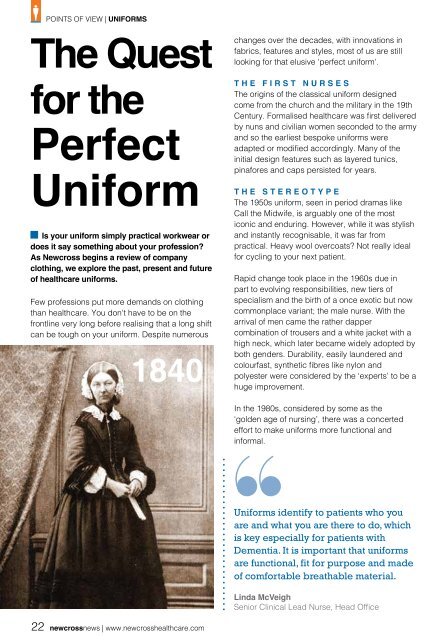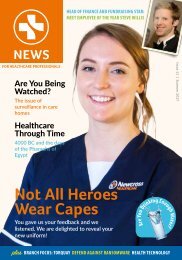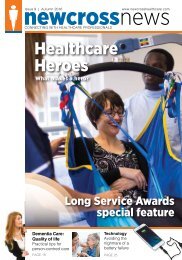NXNews-Issue9-FINAL-ForWeb -160916LowRes
You also want an ePaper? Increase the reach of your titles
YUMPU automatically turns print PDFs into web optimized ePapers that Google loves.
POINTS OF VIEW | UNIFORMS<br />
The Quest<br />
for the<br />
Perfect<br />
Uniform<br />
Is your uniform simply practical workwear or<br />
does it say something about your profession?<br />
As Newcross begins a review of company<br />
clothing, we explore the past, present and future<br />
of healthcare uniforms.<br />
Few professions put more demands on clothing<br />
than healthcare. You don't have to be on the<br />
frontline very long before realising that a long shift<br />
can be tough on your uniform. Despite numerous<br />
1840<br />
changes over the decades, with innovations in<br />
fabrics, features and styles, most of us are still<br />
looking for that elusive 'perfect uniform'.<br />
THE FIRST NURSES<br />
The origins of the classical uniform designed<br />
come from the church and the military in the 19th<br />
Century. Formalised healthcare was first delivered<br />
by nuns and civilian women seconded to the army<br />
and so the earliest bespoke uniforms were<br />
adapted or modified accordingly. Many of the<br />
initial design features such as layered tunics,<br />
pinafores and caps persisted for years.<br />
THE STEREOTYPE<br />
The 1950s uniform, seen in period dramas like<br />
Call the Midwife, is arguably one of the most<br />
iconic and enduring. However, while it was stylish<br />
and instantly recognisable, it was far from<br />
practical. Heavy wool overcoats? Not really ideal<br />
for cycling to your next patient.<br />
Rapid change took place in the 1960s due in<br />
part to evolving responsibilities, new tiers of<br />
specialism and the birth of a once exotic but now<br />
commonplace variant; the male nurse. With the<br />
arrival of men came the rather dapper<br />
combination of trousers and a white jacket with a<br />
high neck, which later became widely adopted by<br />
both genders. Durability, easily laundered and<br />
colourfast, synthetic fibres like nylon and<br />
polyester were considered by the ‘experts’ to be a<br />
huge improvement.<br />
In the 1980s, considered by some as the<br />
‘golden age of nursing’, there was a concerted<br />
effort to make uniforms more functional and<br />
informal.<br />
Uniforms identify to patients who you<br />
are and what you are there to do, which<br />
is key especially for patients with<br />
Dementia. It is important that uniforms<br />
are functional, fit for purpose and made<br />
of comfortable breathable material.<br />
Linda McVeigh<br />
Senior Clinical Lead Nurse, Head Office<br />
22 newcrossnews | www.newcrosshealthcare.com









